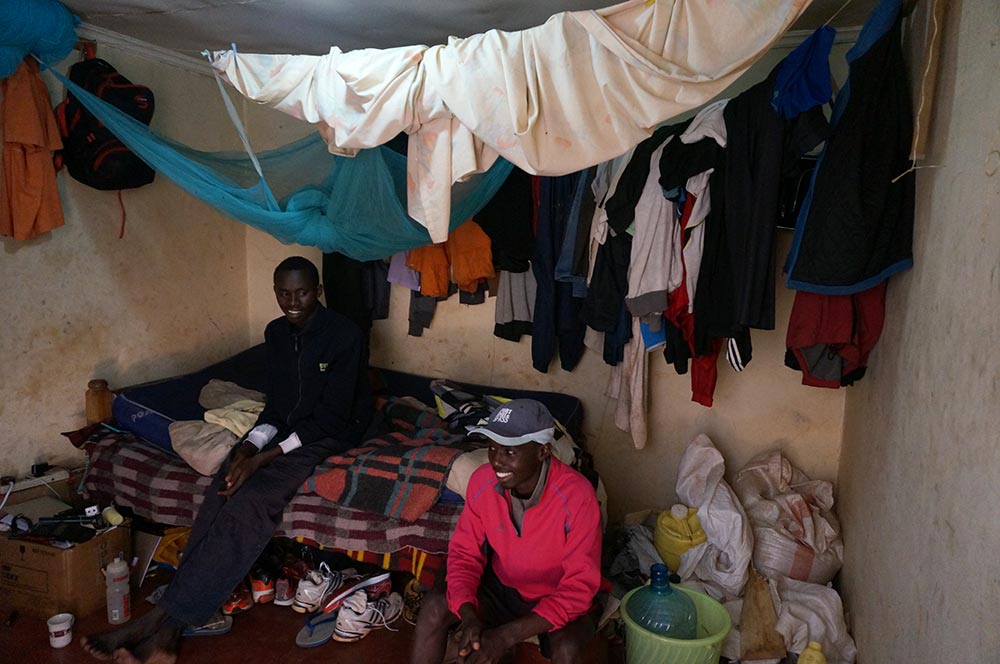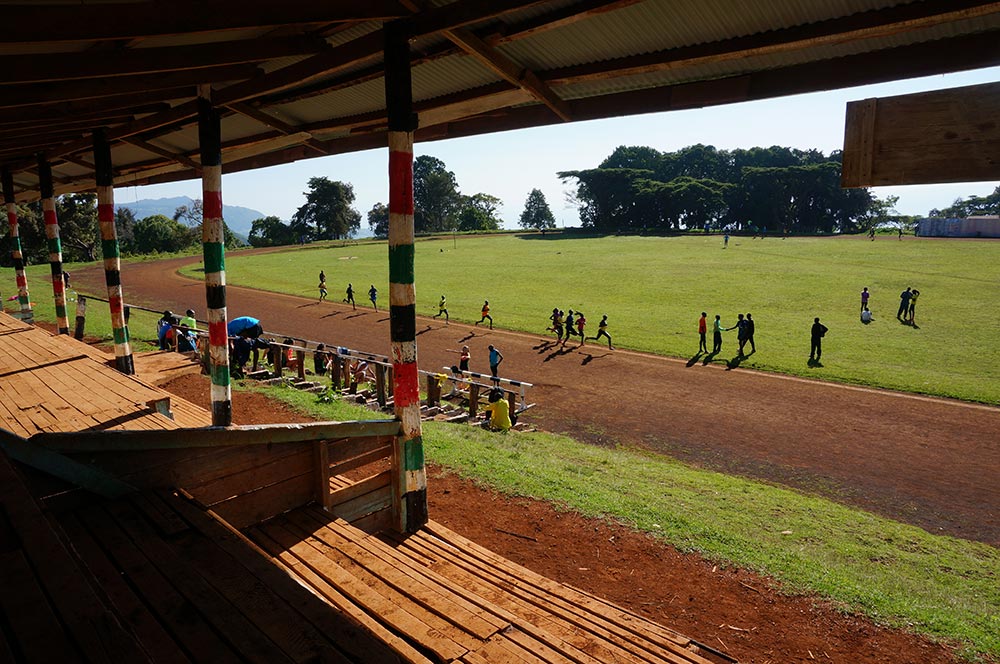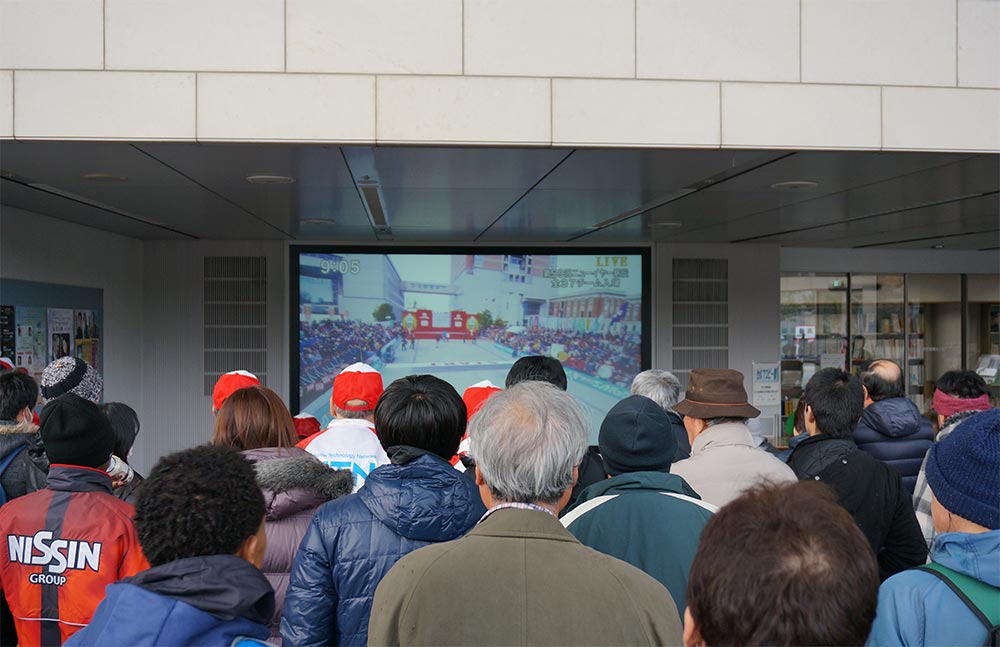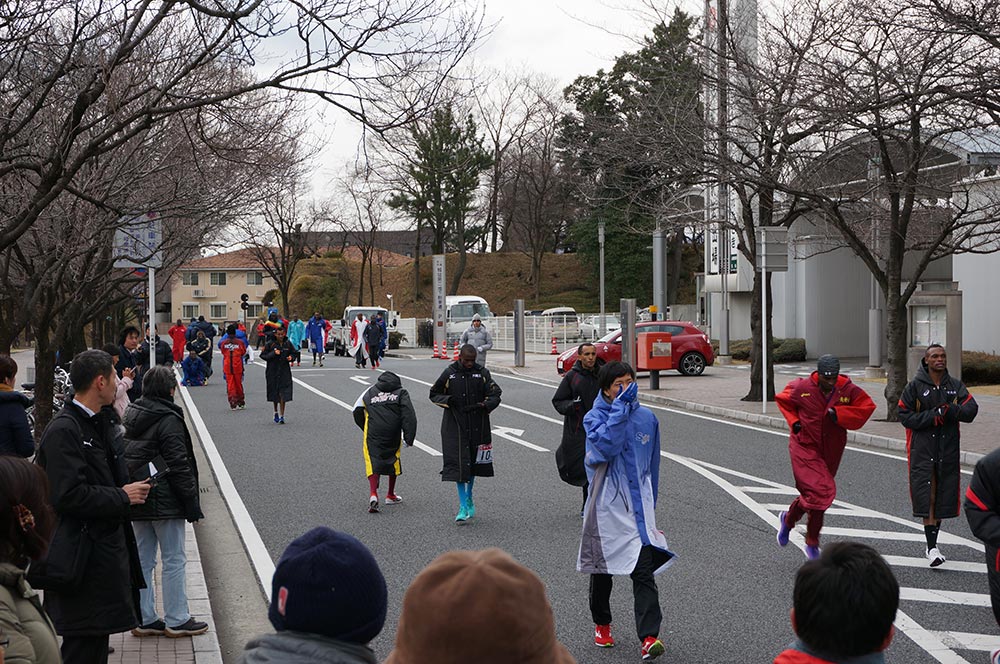"Ekiden" in the New Year: "Maendeleo" and the Gendered Expectations of Kenyan Runners in Japan
Japanese high schools, universities, and corporate-level teams rely on Kenyan male and female distance runners to elevate their institutions to prominence in a domestic market through their performances in ekiden, a style of long-distance road relay racing unique to Japan. Kenyan runners enrolled in Japanese high schools and universities are on full athletic scholarships residing on student visas. Subpar results or injuries may lead to their being replaced by another Kenyan runner, denting their post-graduation hopes of securing a coveted spot to run for a Japanese corporation. Those that run for a corporate team are on one-year contracts, and their prospects for renewals in the mercurial nature of the Japanese corporate sports structure is in the hands of agents, coaches, and employers who constantly evaluate their performances. Kenyan runners, however, understand their purpose in Japan is for fulfilling different objectives centered in Kenya. Measuring success is complicated. The only certainty among many uncertainties is that they must deliver peak racing performances during the early days of the new year to enhance their prospects of safeguarding what is most important to them.
Magical moment
Oshogatsu (お正月, “Japanese New Year”) is observed during the first three days of every new year in Japan. Like American football on Thanksgiving Day in the United States, during oshogatsu, televisions in many households across Japan are tuned to ekiden (駅伝, “long-distance relay race”). Leading off on New Year’s Day is the All-Japan Men's Corporate Team Ekiden Championships, also known as the New Year Ekiden [Fig. 1]. Another ekiden race, the Hakone Ekiden, is a cultural touchstone and takes over the national psyche for the following two days. For people at home who are not distance running enthusiasts, the lengthy broadcast of this university men’s ekiden championship may simply be white noise. But each year, there is a magical moment that can disrupt the metronomic and monotonous nature of the half-day long telecast and suddenly command the attention of passive viewers: a runner vaulting his team from relative obscurity to immediate relevance by passing a number of competitors and winning the stage in record-setting fashion.
In almost all cases, this is done by an international student from Kenya. Out of the 210 student athletes participating in the 2025 edition, there were only six foreign students, all Kenyan. The second stage is where coaches traditionally enter their top runners, and this year, the Kenyan representing Tokyo International University (TIU) provided the magic. After the first stage, TIU was in 14th place, one minute and 48 seconds behind the leading team, Chuo University. By the end of the 23.1km second stage, Richard Etir of TIU passed 12 runners, catapulting his team to second place, only 40 seconds behind the leader. Three hours later, after all five stages were complete, TIU had slid back down to 11th place. After the second day, TIU rebounded respectably to finish eighth overall. No media outlet had favored TIU to win the team title, but Etir’s performance scored a major victory for TIU’s program. The one hour and five minutes he dominated gave TIU at least 50 minutes of screen time. Instead of TIU paying the network to air a commercial, TIU essentially received free advertising thanks to their ace runner. Performances like Etir’s underscore the value Kenyan runners can bring to the Japanese educational institutions and corporations that recruited them. But that still only partially answers why some of the most promising distance runners from Kenya see Japan as a preferable destination, and how only a select few end up half way around the world in a country so culturally and linguistically foreign to them. There’s much more behind what Kenyan runners may encounter along their journeys, and the story of a runner who arrived there decades earlier is a case in point.
From the age of 15, Martin 1 propelled his rural high school to national prominence with his captivating ekiden performances. But it is shortly after he entered college that he forever solidified his place in Japanese distance running lore. He did this at none other than the Hakone Ekiden. For consecutive years, he ensured that the uniform of his college team was front and center on television screens by the time he handed over the tasuki (襷, “traditional sash worn while running”) to his teammate running the next stage. Martin became well known across Japan from these hour-long displays of athletic dominance over not only his Japanese competitors, but also his Kenyan compatriots. My decade of doctoral research coincided with the latter half of Martin’s dozen years in Japan.
“The Hakone Ekiden means nothing in Kenya!”
Kenyan high school and collegiate runners in Japan receive a modest stipend between 50,000¥ and 80,000¥ (approximately €308 to €494), provided to them monthly for purchasing meals and an occasional pair of running shoes. Kenyan student athletes receive only a fraction when compared with the monthly salary of their corporate counterparts. Nonetheless, they are counted on by friends, family members, and others in their local communities in Kenya to make a similar degree of immediate financial contributions soon after arriving in Japan. Thus they often rely on a network of their Kenyan running elders based in Japan, who lend them money to help them deliver on expectations. The communal values prevalent in Kenya shape the ways Kenyan runners in Japan carefully manage the desires of personal well-being and constantly display a readiness to financially assist not only others in Kenya, but also other Kenyan runners in Japan. Most Kenyan student-athletes told me that they made it a goal to redistribute over half of each month’s allowance back in Kenya.
Martin graduated with high school and college degrees before joining the corporate ranks. But his fastest performances as a runner came when he was still in university. While an undergraduate, he began to face adversity in multiple forms: losing two siblings, sporadic injuries, a lengthy battle with alcohol addiction, and more. His struggles as a corporate runner only intensified despite finally earning a monthly paycheck after seven years as an amateur athlete. Driven to rapidly make up for what he perceived in his own words as “years wasted,” he overcompensated by almost always acceding to incessant requests for money coming from both Kenya and other young Kenyan runners based in Japan. He divulged that what caused the greatest shame was enduring harsh criticism from some in Kenya who would highlight the financial success of his Kenyan high school teammate Violet, who came to Japan the same year he did. Martin never came to grips with his resentment of being outperformed by a woman, unable to shake free from feeling inadequate as a man.
The women’s collegiate ekiden is not as lucrative as the men’s and has no counterpart that measures up to the popularity of the Hakone Ekiden. Therefore, university programs eschew recruiting Kenyan women. Violet joined a corporate team straight out of high school and began receiving a monthly salary when Martin was a freshman in college. Martin lamented constant ridicule of being “four years behind her.” When I brought up his accomplishments in the Hakone Ekiden and all the ensuing accolades, he interjected: “The Hakone Ekiden means nothing in Kenya! Nobody knows what that is!” Despite making what he felt was a consistent showing of his largesse back in Kenya, his sense of self-worth was heavily influenced by how he perceived his beneficiaries’ evaluations of his living up to Kenyan norms of what it means to be a ‘real man.’
Maendeleo
More than being a winner or loser, being useful is paramount for the runners I interviewed. 2 Being useful meant exhibiting signs of progress and promise embedded in maendeleo, 3 a Swahili word commonly translated as development, but also meaning forward momentum as well as individual and communal improvements. Because the Kenyan runners in Japan are pursuing a career in sport overseas, they are expected to accomplish maendeleo in both an expedited and grander fashion than what would be expected of them if they never left Kenya. Roughly two-thirds of the 150 Kenyan runners in Japan are men, and ideas of maendeleo among my interlocutors are also gendered, with patriarchal values influencing the different sets of expectations placed on men and women.
In Kenya, men are generally expected to settle down by the age of thirty and become the sole provider for their families, something which is becoming more difficult. A man who can guarantee financial security is considered a good husband and a respectable member of his community. Female runners from Kenya have increasingly accomplished maendeleo, challenging what is appropriate female etiquette by performing the stereotypically masculine role of overseas benefactor. 4 But based on what I observed, they ultimately knew when to retreat, to avoid being regarded by their male partners as a threat to their persona and sense of manhood. 5 Women are expected to bear several children, be good mothers and loyal housewives, and also look after their own siblings, mothers, and grandmothers. For both the men and women I followed, their pursuits of maendeleo while adhering to ascribed gender roles and norms required a great deal of dexterity and endurance.
Kikuyu and Kisii
My first round of Kenya-based fieldwork included time spent in Iten, a high altitude (2400 meters) running oasis in Western Kenya. Famously known in running circles as the Home of Champions, 6 Iten is located about 35 kilometers from the city of Eldoret, another running hub where many of the most elite and decorated athletes in Kenya build lavish homes. Dozens of training camps are situated in the surrounding towns and counties; therefore, thousands who hope to succeed as distance runners move to this region making a full-time commitment to train. One day, two athletes welcomed me to drink chai tea at their one-room apartment in a dilapidated tenement. When I mentioned bass from the boombox rattling the table, they shared a laugh while one teased the other about recently becoming “big time” after winning a local race and signing with an agent [Fig. 2]. The modest earnings from that victory enabled him to purchase a stereo. The joy from acquiring new audio equipment represented a conviction they shared that “more [maendeleo] was to come.”

Fig. 2: Talented runners in Iten with hopes of running overseas reveling in the moment. (Photo by the author, 2015)
Later that afternoon, I went to nearby Kamariny Stadium, where hundreds of athletes train daily [Fig. 3]. In a matter of minutes, in the grassy infield, three runners handed me a folded piece of looseleaf requesting that I pass their contact information along to coaches and agents in Japan. Even when I reminded them that I am a graduate student and do not regard myself as a viable go-between, they insisted that I try to help them. I would discover later on my trip that neither the athletes grinding out intervals at a torrid pace nor the young runners who invited me for tea would likely end up in Japan. Runners like Martin or Violet never passed through Iten.

Fig. 3: Kamariny Stadium in Iten is an iconic training ground where many aspiring runners hope to earn an opportunity to run overseas. However, Iten is not a point of departure for any athletes aiming to reach Japan. (Photo by the author, 2015)
Out of the 42 ethnic groups in Kenya, the Kalenjin are the most renowned for their dominance in long-distance races. However, less than a handful of Kenyan runners based in Japan are Kalenjin. 7 In fact, almost all are Kikuyu and Kisii. Since a top agent recruiting Japanese runners is based in Nyahururu in Laikipia county, an area with a high concentration of Kikuyu, runners that the agent connects with a Japanese team will likely be Kikuyu. Similarly, most athletes in Kisii County will be of the Kisii ethnic group (like Martin and Violet). Moreover, since recruiters are long-established in particular areas in Kenya and have deep ties with particular institutions in Japan, the Kenyan runners at those Japanese high schools, universities, and companies will almost always be of the same ethnic background.
One elite Kalenjin runner who did make it to Japan was attending vocational school in Kisii County when he was noticed by a prominent Japanese recruiter. During the years he ran for a Japanese corporation, he earned a medal in a track event at the Olympic Games. Many Kalenjin runners are from Elgeyo-Marakwet County – where Iten is located – or neighboring counties. Had he been among the runners training at Kamariny Stadium, he presumably would not have earned an opportunity to run professionally in Japan. Instead, due to his elite level of talent, he most likely would follow the paths of other top-flight Kalenjin distance runners. Those who can gain recognition from agents usually compete overseas in Europe and the United States, but primarily live and train year-round in Kenya. Others may earn athletic scholarships for university running programs in the United States. Notably, all four of the medals earned by Kenyans at the Olympics Games in the men’s marathon between 1988 and 2008 were by three Kikuyu runners who were based on Japanese corporate teams.
New Year’s Day
The most important day of the year for corporate male runners is New Year’s Day in the city of Takasaki in Gunma Prefecture. I first went to the New Year Ekiden in 2015, hoping to watch Martin race and chat with him afterwards. Unfortunately, I only got to accomplish one of those two objectives. In the whole relay race, it is only the second stage in which foreign athletes are eligible to compete. 8 Thus, teams with two Kenyans can only place one on their roster for the New Year Ekiden. The race organizers had gradually reduced the length of this stage over the years in an attempt to appease corporations with all-Japanese squads, which have lodged complaints claiming other teams with foreign runners have an unfair advantage. Nineteen of the 41 teams in 2015 had Kenyans entered to run in what has been dubbed “the international stage” by running pundits. Forty-five minutes before the leaders were expected to arrive, many people on the first floor of Takasaki City Hall, including some Kenyans, directed their attention towards a giant screen showing the live broadcast of the competition [Fig. 4].

Fig. 4: Athletes, coaches, agents, and other onlookers watching the live telecast of the New Year Ekiden in the first-floor lobby of Takasaki City Hall in Gunma Prefecture. (Photo by the author, 2015)
The second floor of the building was designated for athletes to change into their racing singlets, stretch, and keep warm until racing in wintry weather [Fig. 5]. There was limited time for brief conversations with other athletes, coaches, and some of the middlemen that control their fate in Japan. The stakes of the second stage are high: a strong performance in the second stage can solidify a contract renewal [Fig. 6]. Even those with Olympic pedigrees find themselves without a contract if their running prowess does not translate into convincing performances on New Year’s Day. I noticed that Martin had not been stretching, nor did he go outside for a warm-up. To Martin’s detriment, his head coach had chosen the other Kenyan on his team to race that day. This foreshadowed an earlier-than-hoped-for return to Kenya. If there was any silver lining for Martin, the position he ‘vacated’ would give his Kenyan teammate at least one more chance to make the grade and augment his own prospects for accomplishing maendeleo.

Fig. 5: Athletes, coaches, and agents in the common space on the second floor of Takasaki City Hall. A camera crew is also gathering pre-race footage. (Photo by the author, 2015)

Fig. 6: Runners in their warm-up gear are making final preparations just minutes before they will race in Stage 2 of the New Year Ekiden. (Photo by the author, 2015)
Final reflections
In contrast to most migrant workers that usually blend in with the general public, the dominance of Kenyan runners in Japan is widely witnessed, often televised as well as heavily covered and critiqued in both print and online media. Although Martin could hide his personal struggles, he could not conceal his regression as a runner and the decline in his athletic capabilities. He ended up back in Kenya as a result, and for a while, did not have a constant stream of income. According to other Kenyan runners, Martin eventually moved to the United States and found employment as a caretaker for the elderly – an occupation that men in Kenya typically disdain. It is unclear how many in Kenya know of his current whereabouts and circumstances. Martin seldom updates his social media accounts, but when he does, he uploads pictures of himself from his earlier days running in Japan. His posts are part strategic ambiguity, part reputation management, and part deliberate reassurances for anyone who visits his social media platforms. The money Martin remits to Kenya is far less than when he was a corporate runner, but it nevertheless continues to provide for his wife and children, as well as his parents, and in-laws. It even sustains a few local investments in farming. He continues to accomplish maendeleo, preserving his image as a capable man.
Violet’s return to Kenya preceded Martin’s by a few years. She did so as she was still trending upwards with her running performances, arguably before reaching her peak. Yet neither her husband nor anyone else in Kenya suggested that she reconsider waiting another year, even when she received contract offers. She complied with Kenyan ideals of respectable womanhood by starting a family soon after returning home. With her elevated status from her successful investments of maendeleo (purchasing and renting out properties, building homes, paying school fees for friends and relatives, buying livestock, and employing others), she is regarded as an esteemed leader of her community. To safeguard her husband’s masculinity, she always made sure to deflect praise from others, and she never openly took credit for their joint maendeleo, made possible mostly from her earnings in Japan. Even when her husband’s political ambitions did not go as planned, she proved her unwavering loyalty by joining him as an asylum seeker overseas.
Most Kenyan runners in Japan will never reach the heights of ekiden success like Martin or Violet. But for Kenyan runners, the very opportunity to live and compete in Japan is highly significant. If there is a Kenyan in the ekiden, it is not a matter of if, but when a magical moment will occur. Talent, tenacious effort, and steely determination are critical components of a strong performance. However, these runners are ultimately fueled by their desire to live up to the expectations, obligations, and fragile prospects of maendeleo, while also adhering to Kenyan norms of male and female respectability. Each year, the next wave of Kenyan runners in Japan race ekiden as hard as they can, especially during oshogatsu, harnessing their dexterity and endurance to succeed at achieving goals that are far more significant to them than winning, breaking records, and stardom. 9
Michael K. Peters is an Assistant Professor in the Faculty of Global Interdisciplinary Science and Innovation at Shizuoka University (Japan). His most recent research focuses on naturalized players in the B.League, a professional men’s basketball league in Japan. Email: peters.michael@shizuoka.ac.jp